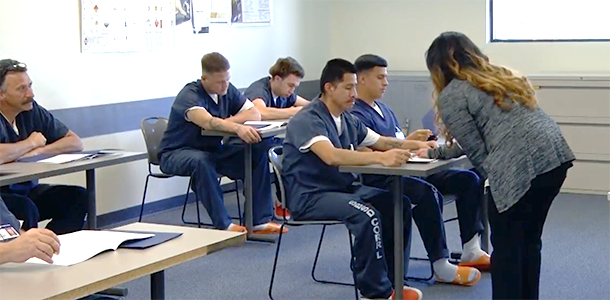
(Image from San Bernardino County Sheriff’s Department video)
For every dollar invested in correctional education, research shows a return of four to five dollars, according to a report released by Corrections to College California. Providing a college education to incarcerated individuals can save the state millions through reduced recidivism rates and increased earning power, say the authors.
“Don’t Stop Now,” highlights the progress made in the past three years by the Corrections to College California project. Started in 2014, the effort worked toward bringing higher education to the state’s population of current and formerly incarcerated individuals. According to the report, “higher education reduces recidivism, changes lives, and builds stronger communities.”
The project is part of Renewing Communities, a four-year initiative to build a network linking corrections to college in California. It is a joint initiative of The Opportunity Institute and the Stanford Criminal Justice Center.
Before the project began, the state offered little or no support to providing higher education to individuals who are or have been incarcerated. Subsequently though, the landscape has changed and much progress has been achieved including:
- Face-to-face transferable college-courses are now offered in 34 of the 35 state prisons, providing degree-building credits to nearly 4,500 individuals each semester.
- The California State University system provides support services for formerly incarcerated students through Project Rebound offered on nine campuses.
- Project Rebound has expanded to include Project Underground on two University of California campuses and a similar program at a third of California’s 114 community colleges.
The report also offers a roadmap to other states on how to reduce recidivism rates by educating criminal justice involved individuals. Those recommendations include:
- Allow incarcerated individuals to have face-to-face college courses while in custody and count them as college students for budgetary considerations. This is included in SB1391, which was passed in 2014.
- Institute programs such as the California College Promise Grant, which covers tuition for low-income students including those who are or who have been in custody.
- Do not impose admissions barriers to colleges and universities for people who have been in the criminal justice system. California’s three state systems (US, CSU and Community Colleges) have never imposed those restrictions.
As the report’s name suggests, “Don’t Stop Now” urges state leaders in education and corrections to continue the project’s momentum toward educating this population. Corrections to College California will hold a statewide summit next month to focus on quality, student support, degree completion, job attainment, and transfer.

